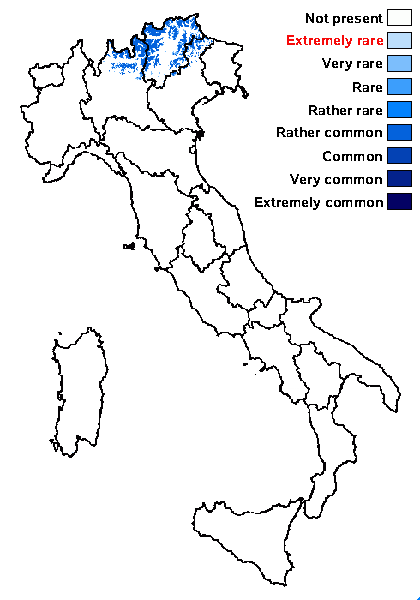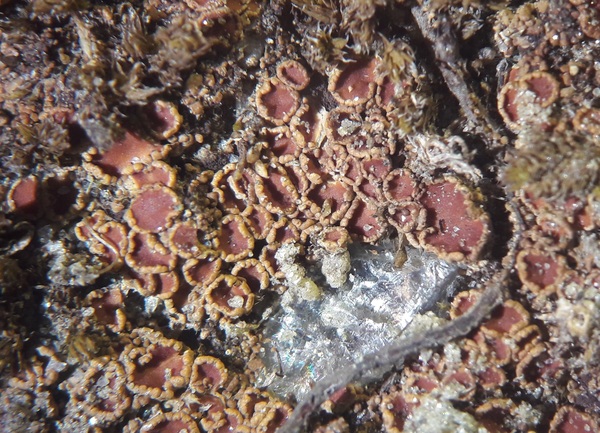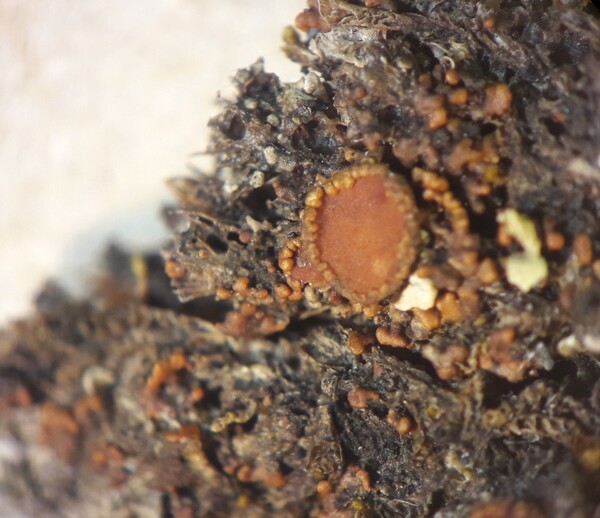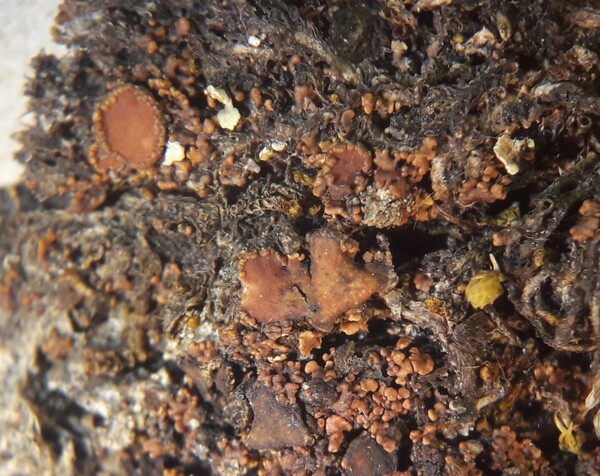Psoroma tenue Henssen var. boreale Henssen
in Henssen & Renner, Mycotaxon, 13: 441, 1981.
Synonyms:
Distribution: N - Ven (Nascimbene & al. 2021), TAA (Jørgensen 2004: Austria, near the border, Thor & Nascimbene 2007, Breuss 2012b, Bilovitz & al. 2014, 2014b, Nascimbene & al. 2022), Lomb (Anzi Lich. Lang. Exs. 64: Jørgensen 2004).
Description: Thallus crustose to subsquamulose, cinnamon brown (with an orange hue) when dry, green when wet, strongly glossy, with interspersed blackish brown granules (cephalodia). Squamules globose, often aggregated, up to 0.4 mm wide and 150-300 µm thick. Cephalodia granular to branched-coralloid, up to 0.8 mm wide, corticate by one or two rows of cells. Upper cortex paraplectenchymatous, 20-25(-30) µm thick; medulla white, of loosely reticulate hyphae; lower cortex occasionally developed, paraplectenchymatous, 30-40 µm thick. Apothecia lecanorine, to 2 mm across, with a mostly flat, brown to dark brown disc, and a granular thalline margin. Epithecium brown; hymenium colourless, 90-120 µm high, I+ dark blue; paraphyses simple, the apical cells not swollen; hypothecium colourless or almost so, often extending into a stipe towards the base. Asci 8-spored, narrowly ellipsoid or cylindrical, the apex with a K/I+ deep blue central tube in a paler-staining tholus, and an internal, K/I+ dark blue ring-structure. Ascospores 1-celled, hyaline, ovoid, 19-22(-24) x 7-12 µm, with a warted-ridged epispore. Pycnidia rare, small, pale brown. Conidia bacilliform, 2-4 x c. 1 µm. Photobiont chlorococcoid in thallus, cyanobacterial (Nostoc) in cephalodia. Spot tests: K-, C-, KC-, P-, UV-. Chemistry: thallus and apothecia with pannaric acid, porphyrilic acid methyl ester and a related unknown substance. Note: an arctic-alpine, circumpolar lichen weak in competition, found on wet, naked soil, near glaciers or late snow-beds over siliceous substrata; certainly more widespread in the nival belt of the Alps, but easily confused with P. hypnorum (see Jørgensen 2004 and Breuss 2012b), though rather easily recognized by the shiny brownish colour and the flat apothecia.
Growth form: Crustose
Substrata: soil, terricolous mosses, and plant debris
Photobiont: green algae other than Trentepohlia
Reproductive strategy: mainly sexual
Commonnes-rarity: (info)
Alpine belt: rather common
Subalpine belt: very rare
Oromediterranean belt: absent
Montane belt: absent
Submediterranean belt: absent
Padanian area: absent
Humid submediterranean belt: absent
Humid mediterranean belt: absent
Dry mediterranean belt: absent

Predictive model
Herbarium samples
Growth form: Crustose
Substrata: soil, terricolous mosses, and plant debris
Photobiont: green algae other than Trentepohlia
Reproductive strategy: mainly sexual
Commonnes-rarity: (info)
Alpine belt: rather common
Subalpine belt: very rare
Oromediterranean belt: absent
Montane belt: absent
Submediterranean belt: absent
Padanian area: absent
Humid submediterranean belt: absent
Humid mediterranean belt: absent
Dry mediterranean belt: absent

Predictive model
| Herbarium samples |
 INDEX FUNGORUM
INDEX FUNGORUM
 GBIF
GBIF
 DOLICHENS
DOLICHENS






